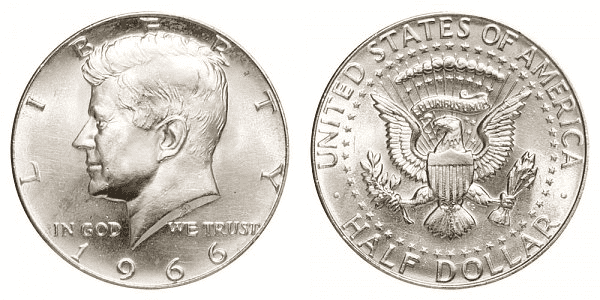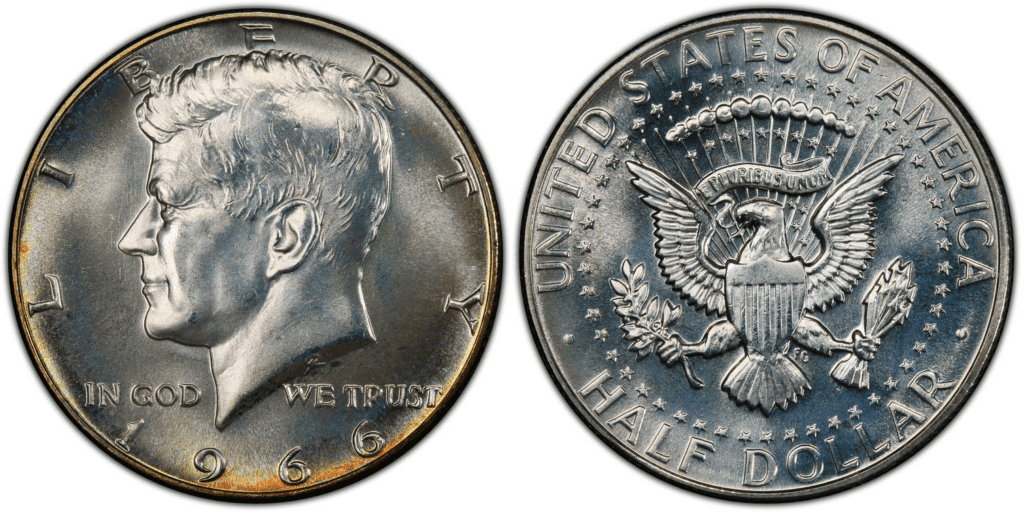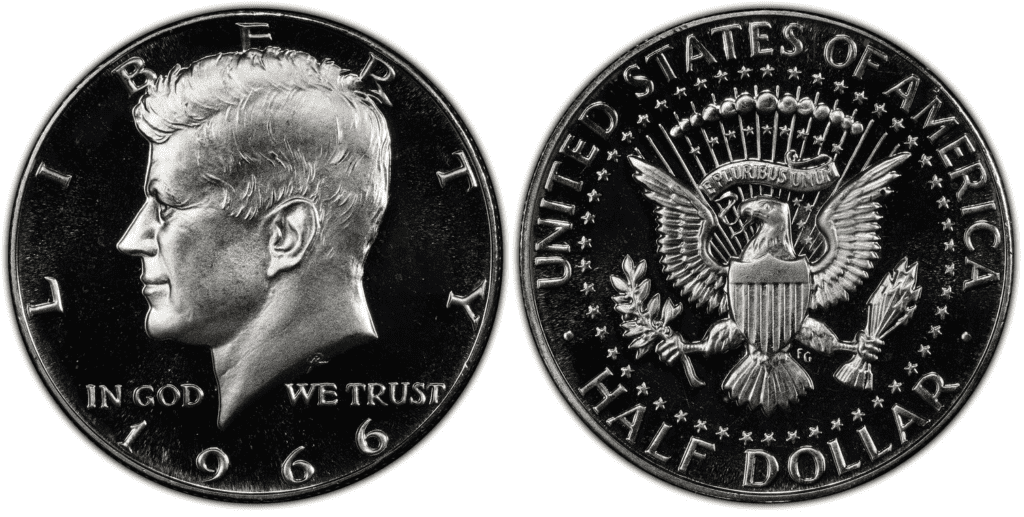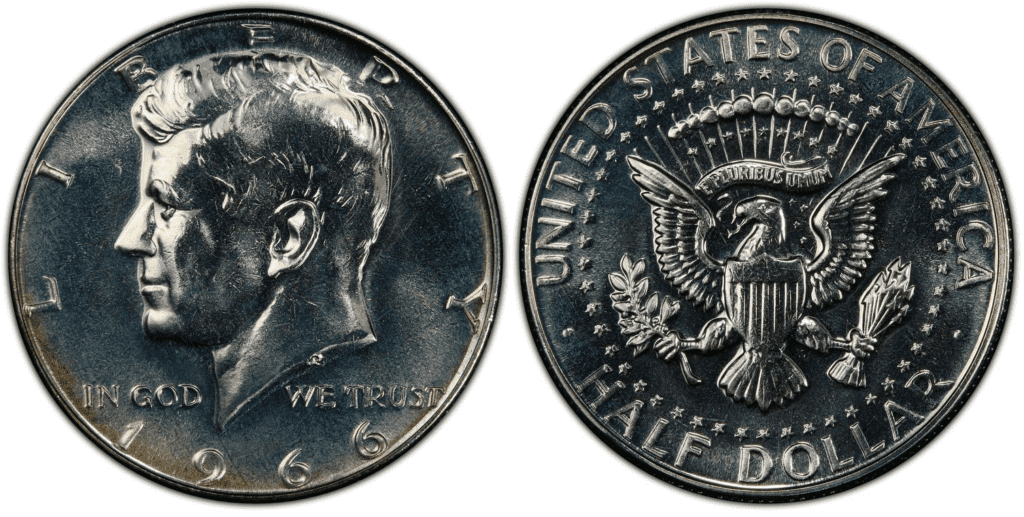What Is the 1966 Kennedy Half Dollar Made Of?
The Kennedy half dollar, a fifty-cent coin, was first created by the US Mint in 1964. Today, the coin is still made. Congress approved what was intended to be a memorial a little over a month after John F. Kennedy, the 35th president of the United States, was shot and killed. The Mint used already finished sculptures by artists Gilroy Roberts and Frank Gasparro to produce the new coins for the first time in January 1964.
When the silver coins were first released in March 1964, both coin collectors and people who wanted to honour the late president sought them out. The Mint greatly increased output, but due to the currency’s high collectibility, very few people ever used it. These coins became even more valuable as silver’s price increased and were frequently melted down for their 90% silver content.
Because of this, the metal composition was modified to 40% silver and 60% copper, resulting in a total weight of 11.5g, just a year after the creation of the first Kennedy half dollar. The half dollar has remained a highly collectable coin despite this modification.
The coin’s profile bust of John F. Kennedy, the phrase “LIBERTY” along the top rim, and the year of mintage are all designs by Gilroy Roberts. On both sides of his neck is written: “IN GOD WE TRUST.” The reverse face was created by Frank Gasparro and features a large-winged eagle carrying an olive branch on one foot and a bundle of arrows in the other. A banner with the phrase “E PLURIBUS UNUM” is displayed above the eagle’s head and a circle of stars surrounds it. On either side of the upper rim, the phrases “HALF DOLLAR” and “UNITED STATES OF AMERICA” are printed.
In 1966, a gallon of gasoline cost 5 shillings (or 26p) and the average cost of a home was £3,840. John Lennon’s comment that the Beatles were more famous than Jesus, the adoption of a dangerous warning on cigarette packs, several USSR and US space flights, and of course England’s infamous victory over Germany to win the world cup, were all key events of 1966.
1966 Kennedy Half Dollar Varieties
1966 Kennedy Half Dollar (No Mint Mark)
Edge: 150 Reeds
Place of minting: Philadelphia and Denver
Year of minting: 1966
Face Value: $0.50
Quantity produced: 108,984,932
Composition: 40% silver and 60% copper
Mass: 50 grams
Diameter: 15 millimeters
Thickness: 6 millimeters

As an attempt to combat low circulation numbers, largely due to avid collecting, mint marks were removed from all US coinage for five years, starting from 1965.
1966 S Kennedy Half Dollar Proof
Edge: 150 Reeds
Place of minting: San Francisco
Year of minting: 1966
Face Value: $0.50
Quantity produced:2,200,000
Composition: 40% silver and 60% copper
Mass: 50 grams
Diameter: 15 millimeters
Thickness: 6 millimeters

List Of 1966 Kennedy Half Dollar Errors
1966 S Kennedy Half Dollar Deep Cameo

Only coins that demonstrate a strong and intense frosted finish on the devices and have outstanding visual appeal are accorded the Deep Cameoclassification. Only the first few coins produced by a fresh set of proof dies exhibit the devices’ extraordinary frosted finish.
1966 50C SMS Doubled Die Obverse (Special Strike)

A form of die variation on a coin is a doubled die. A die variety is a mistake on a die that frequently produces coins. As a result, different instances of the same variety will be present.
To be more precise, a doubled die variety happens when an error during the hubbing process doubles the design on the die.
1966 50C SMS No “FG” (Special Strike)

While the No FG variation may be present on any Kennedy half, there are some specific difficulties to which the No FG is commonly attributed and which also make it extremely valuable.
The 1966 SMS, 1972-D, and 1982-P No FG Kennedy half dollars are among the most prized examples.
How Much Is the 1966 Kennedy Half Dollar Worth Today?
In circulating condition, the Kennedy Half Dollar from 1966 is worth at least its weight in silver.
The silver melt value of this coin is $3.50 as of January 10, 2023. (Based on the $23.64 per ounce spot price for silver as of this writing)
However, the majority of the stock of these coins is uncirculated Kennedy half dollars. The majority of these coins were never used in trade because they were initially saved by collectors.
| Coin | Condition
Circulated/Uncirculated? Mint or Proof? |
Grade | Mintage | Value |
| 1966 Kennedy Half Dollar | Circulated | G4-AU50 | 108,984,932 | $5.23 |
| 1965 Kennedy Half Dollar | Uncirculated | MS60-65 | 108,984,932 | $7.99-29 |
| 1966 Kennedy Half Dollar Proof | MS64-67 | Uncirculated | 2,200,000
|
$17-70 |
| 1966 Kennedy Half Dollar Proof Deep Cameo | MS65-68 | Uncirculated | 2,200,000 | $475-7,000 |
| 1966 Kennedy Half Dollar Proof No FG | MS64-67 | Uncirculated | 2,200,000 | $175-2,600 |
How Does The Grading System Work?
The Sheldon Scale is used by numismatists to provide a numerical value to coins. The Sheldon Scale goes from poor (P-1) to perfect mint state (P-1) (MS-70). Coins were originally evaluated using words to reflect their condition (Good, Fair, Excellent, Etc.). Unfortunately, coin collectors and dealers had different ideas about what each of these terms represent.
Professional numismatists joined together in the 1970s and established coin grading standards. These numismatists now assign grades at key places on the seventy-point scale, using the most regularly utilized numeric points in conjunction with the original adjective grade. The following are the most common coin grades:
- (P-1) Poor – Indistinguishable and probably damaged; if used, must have a date and mintmark; otherwise, rather battered.
- (FR-2) Fair – Nearly smooth, but without the damage that a coin graded Poor often possesses. The coin must have enough detail to be identified.
- (G-4) Fair – Inscriptions have merged into the rims in some areas, and important elements have been mostly erased.
- (VG-8) Very Good- A little weathered, but all of the primary design elements are visible, albeit faintly. There is little if any, central detail left.
- (F-12) Good – The item is very worn, yet the wear is even, and the overall design details stand out clearly. Rims are almost completely isolated from the field.
- (VF-20) Very Fine – Moderately weathered, with some finer features still visible. The motto or all letters of LIBERTY are readable. Both sides of the coin have entire rims that are separated from the field.
- (EF-40) Extremely Fine – Gently used; all gadgets are visible, and the most important ones are bold. The finer details are bold and clear, however, light wear may be seen.
- (AU-50) Uncirculated – Slight evidence of wear on the coin’s design’s high points; may have contact marks; eye appeal should be adequate.
- (AU-58) Uncirculated Choice – Slight traces of wear, no severe contact marks, almost full mint shine, and great eye appeal.
- (MS-60) Mint State Basal – Strictly uncirculated; no indication of wear on the coin’s highest points, but an unsightly coin with reduced luster, visible contact marks, hairlines, and other flaws.
- (MS-63) Mint State Acceptable – Uncirculated, but with contact scratches and nicks, little reduced shine, but otherwise appealing appearance. The strike is weak to average.
- (MS-65) Mint State Choice – Uncirculated with great mint shine, very little contact blemishes, and exceptional eye appeal. The strike is unusually severe.
- (MS-68) Mint State Premium Quality – Uncirculated with superb luster, no obvious contact marks to the naked eye, and exceptional eye appeal. The strike is quick and appealing.
- (MS-69) Almost Perfect Mint State – Uncirculated with perfect brilliance, a sharp and appealing strike, and extremely good eye appeal. A near-perfect coin with minor imperfections in the planchet, strike, and contact markings (seen only under 8x magnification).
- (MS-70) Mint State Perfect – Under 8x magnification, there are no tiny imperfections discernible; the strike is crisp, and the coin is perfectly centered on a beautiful planchet. Rarely seen on a coin, this coin is bright and whole, with original luster and exceptional eye appeal.
Where To Buy Or Sell 1966 Kennedy Half Dollar?
The majority examples of 1966 Half Dollars are available for purchase and trade on online markets because there are so few uncommon or exceptional pieces to be found in this mintage year. You should only think about going to speciality stores, auctions, or dealers like Heritage Auctions. if you believe your coin has remarkable qualities. Before selling, definitely check for any doubling or missing ‘FG’ initials, or the ‘frosted’ look seen in deep cameo coins as these factors can increase the value of the coin greatly. Ask queries on coin collecting forums like the U.S. Coin Forum if you’re unsure of the rarity of your 1966 half dollar. It is recommended to use services like PCGS to grade your coin.
FAQs
Where is the mint mark on a 1966 half dollar?
Due to the 1965 coinage act, there were no mint marks present on the 1966 Half Dollar
How much silver is in a 1966 Kennedy half dollar?
The 1966 Kennedy Half Dollar has a 40% silver composition with the rest comprising of 60% copper.
What is the 1966 50C SMS No “FG” (Special Strike) – Half Dollars worth?
No FG Half Dollars are typically worth anywhere between $175-2,600, depending on the condition of the coin.
